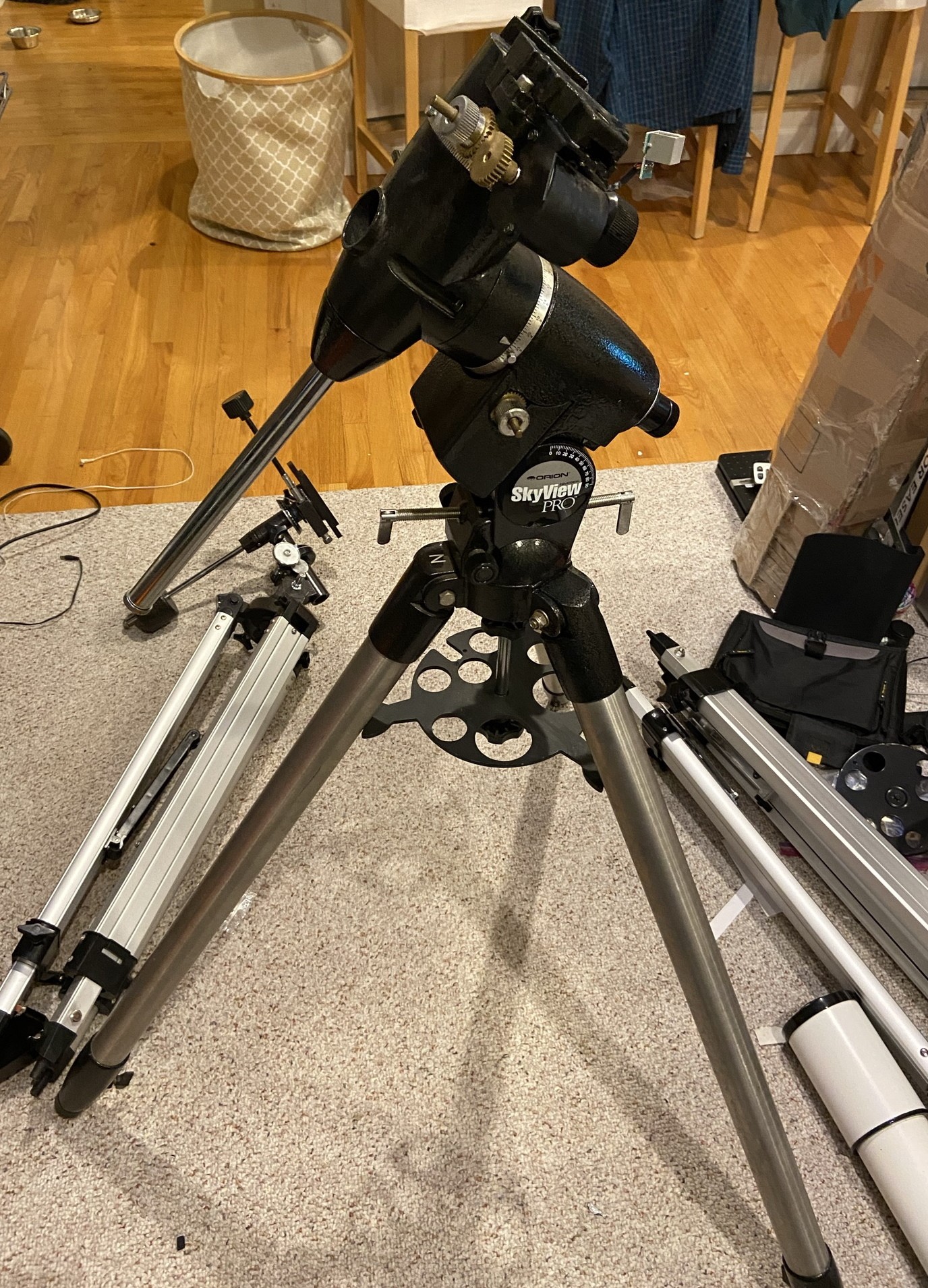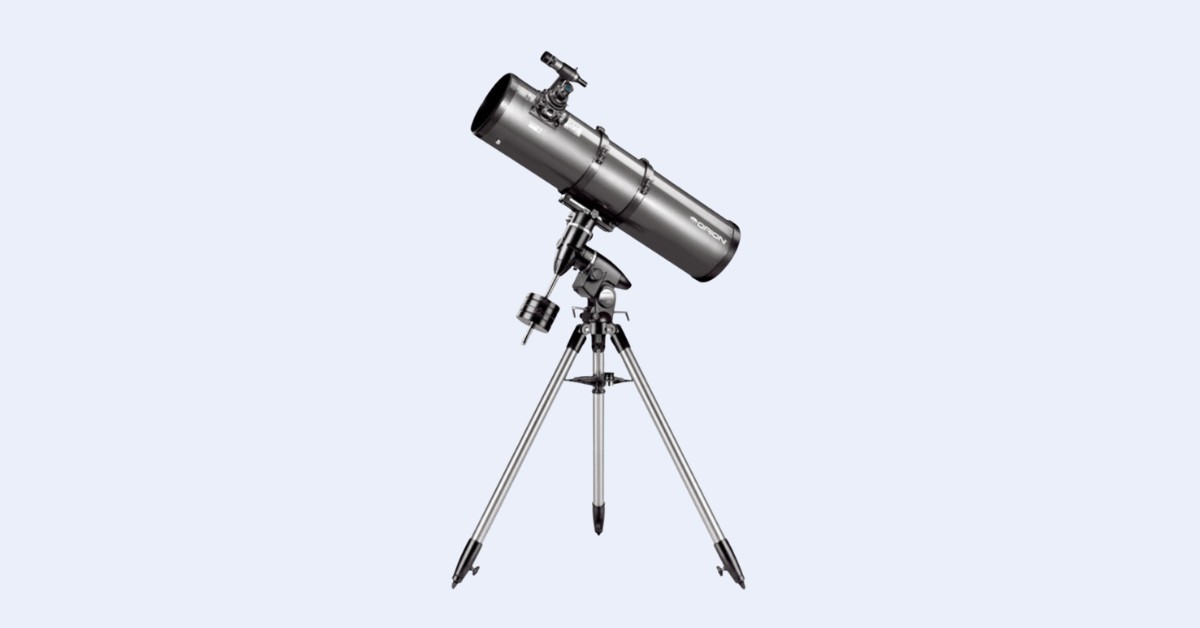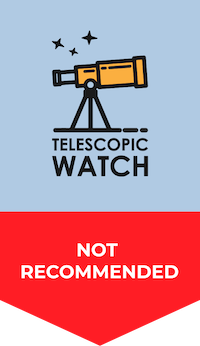Optic’s Resemblance with Orion’s XT8 Dobsonian
The optical tube of the SkyView Pro 8” is an 8” (203mm) f/5 (focal length 1000mm) Newtonian reflector.
Essentially, SkyView Pro 8 (f/5) is one f-stop shorter than Orion’s XT8 Dobsonian (f/5.9) and the construction is, quite literally, a chopped-down XT8 tube with a faster primary mirror. The primary mirror can be collimated without tools. The whole thing is rolled steel, so I hope you get the idea.
However, the SkyView Pro 8” differs from the XT8 in that its quality control seems to be a little less stringent than that of the XT8. The optics in many of the 8” f/5 Newtonians sold by Orion (and also repackaged by Celestron, Meade, Konus, and others) seem to trend towards mediocrity at best, with quite a few being downright poor. It shouldn’t be significantly more difficult to make an 8” f/5 to a similar standard as an 8” f/6, but for whatever reason, the optics I observe in these 8″ f/5 scopes are just a little lacking.
They almost have undercorrection (resulting in spherical aberration) and sometimes turned-down edge (resulting in even more spherical aberration as well as other issues contributing to softness of the image). Other users have suffered from these issues, but there are also a lot of reports of very good ones.
It’s also a bit harder to collimate an f/5 than an f/6 telescope, although fortunately not by much. However, you will need a collimation tool; check out our collimation guide to learn more.
A Fairly Good Crayford Focuser
The focuser on the SkyView Pro 8” is a 2” single-speed Crayford, which works just fine. Older units have a 2” rack-and-pinion that isn’t as good and also have plastic knobs that dig into our hands.
A dual-speed focuser would have been nice if you were planning on using the scope for high-resolution lunar and planetary observing or any kind of astrophotography. But the optics aren’t up to the task of the former and the mount isn’t up to the task of astrophotography either.
Balancing Issues with the Rotating Rings
The SkyView Pro 8” attaches to its mount with a pair of rings and a dovetail plate. In practice, we will frequently need to rotate the tube in its rings as we use it to keep the eyepiece in a comfortable position.
However, rotating the tube in its rings means we will probably bump the telescope, slide it back or forward and ruin balance, etc. So you’ll need a pair of Wilcox rings or some other DIY solution to help alleviate this. There’s a reason those old-fashioned scopes had those rotating rings!
The Fairly Good Accessory Set
The SkyView Pro 8” includes two 1.25” Orion-branded Sirius Plossl eyepieces: a 25mm providing 40x and a 10mm providing 100x.
Both of these are fairly good eyepieces. For viewing most deep-sky objects, you’ll want to use the 25mm eyepiece, and for smaller targets like globular clusters, double stars, the Moon, and the planets, the 10mm provides enough magnification to resolve small details.
For a finder, the SkyView Pro 8” comes with an 8×40 straight-through unit. I know this is a rather odd size, but it works almost as well as a 50mm finder and provides an upside-down view similar to that through the main telescope itself.
You could swap it out for a 9×50, a right-angle finder, or a reflex sight. But I think that in this case, with the equatorial mount, the 8×40 is probably the best solution—a bigger and heavier finder could cause balance problems anyway.
The Unsteady Skyview Pro Mount

The SkyView Pro mount actually isn’t a bad mount at all. It’s similar to the Sky-Watcher EQM-35 mount that I recommend, but stripped of electronics and with a black instead of a white finish.
This mount has been around for a while, and it has little in the way of plastic parts or quality issues. The problem is capacity.
The capacity of the SkyView Pro mount is, rather optimistically, rated at 20 pounds. And I hope you already know that we should never throw the full listed capacity onto an equatorial mount. Unfortunately, that’s not the case here.
The SkyView Pro 8” f/5 optical tube weighs 16.5 pounds bare, without the rings or dovetail bar, which automatically push it up by about 3 pounds. The finder is another pound with its bracket. The eyepieces are another few ounces. So the stock configuration is already about a pound heavier than the maximum listed capacity of the SkyView Pro.
To make matters worse, the massive optical tube presents a huge moment arm that makes the whole thing even shakier. The end result is that the whole scope is remarkably unsteady.
Additionally, the two supplied 7-pound counterweights are barely enough to balance the telescope in the stock configuration, which is a bit concerning. They also have to be slid to the bottom of the counterweight shaft in order to do so at all, unlike what is depicted in photos of the scope.
The Impracticality of Adding GoTo or Motor Drive
The SkyView Pro is also offered in a GoTo configuration, both as a pre-supplied package and as an aftermarket add-on. But in practice, due to the exceedingly high weight of the 8” OTA, I’ve personally experienced SkyView Pro struggling to slew accurately with the GoTo system attached.
There’s also a dual-axis motor drive system available as an add-on. This is nice too, but not necessary.
I’d like to make one thing crystal clear. With the SkyView Pro 8, neither the GoTo nor the dual-axis drive configuration realistically permit astrophotography beyond that of the Moon and planets. The mount is barely able to hold a telescope half the size of the 8” f/5 optical tube for long-exposure astrophotography and was never really designed for such a purpose anyway.
Should I buy a Used Orion SkyView Pro 8?
A used SkyView Pro 8 might be a bargain. You could sell the mount and keep the tube, build or buy a Dobsonian mount for it, and have a pretty decent visual scope for a whole lot of money.
However, make sure the mirror coatings are okay and that the mount moves smoothly without any problems.
And prepare to pay less if you’re getting an older unit with the rack-and-pinion focuser and not a Crayford unit.
Alternative Recommendations
The SkyView Pro 8 is basically at the bottom of our rankings list in its price range, so almost anything in our “recommended” category is probably an improvement. Here are some of our top picks:
- The Apertura AD8/Zhumell Z8/Orion SkyLine 8 has better optics, better accessories, a dual-speed focuser instead of a single-speed focuser, and an easy-to-use, rock-steady Dobsonian mount.
- For a bit extra, the 10” Apertura, Zhumell, and Orion Deluxe Dobsonians offer more aperture with the same great features.
- If you must have an equatorially-mounted scope, the Celestron Omni XLT 150 has a much sturdier mount and better optics, albeit with a smaller aperture.
Aftermarket Accessory Recommendations
If you happen to be stuck with a SkyView Pro 8, the main accessory we’d recommend is a 6mm “gold-line” eyepiece. It’ll give you 166x, which is a good magnification for viewing smaller deep-sky objects, the Moon, the planets, and double stars, without pushing beyond what the mediocre optics of these scopes—or typical atmospheric conditions—can handle.
An ultra-high-contrast, or “UHC,” nebula filter screws onto your eyepiece and provides a contrast enhancement to many of the emission nebulae that dot the night sky, like the Orion Nebula, the Lagoon, and the Swan. It also makes borderline-invisible targets like the Veil and Rosette Nebula much easier to see, especially under less-than-ideal viewing conditions like light pollution or moonlight. The Orion UltraBlock is our pick and comes in 1.25” and 2” sizes – get the 2” model if you plan on using 2” oculars at all, as it can simply screw onto the 2” to 1.25” adapter for use with 1.25” eyepieces.
What can you see with Orion Skyview Pro 8 EQ?
The SkyView Pro 8” has a large enough aperture that it is great for viewing deep-sky objects.
I could resolve the outskirts of globular clusters like M2, M3, M13, M15, M22, and M92 into individual stars at high magnification, as well as colorful planetary nebulae and their tiny details when atmospheric conditions allow. Open star clusters look magnificent and will dazzle with colors too.
The visibility of galaxies and any other sort of extended, non-stellar objects with any telescope is heavily influenced by your light pollution levels.
Only the brightest galaxies can be seen as ghostly vestiges of their true selves under a light-polluted sky, with little to no detail visible besides the occasional dust lane or elongated ovoid shape. At a dark sky site with the Milky Way clearly visible overhead, an 8” telescope like the SkyView Pro—even with its mediocre optics—shows us details of thousands of galaxies and the beautiful spiral arms of several dozen of them. Whereas under the city sky, only the brightest galaxies can be seen as pale, dim fuzzballs. Under dark skies, however, I can easily see the spiral arms of M51 and M33 (M101 and M81 are a bit tougher), the dust lanes of M82 and M108, and numerous details in the Andromeda Galaxy, M31, such as its two orbiting companions, M32 and M110, a clump of stars known as NGC 206, the disk of the galaxy itself, and multiple dust lanes.
Emission nebulae like the Orion Nebula (M42) and Swan Nebula (M17) look great even from suburban skies, though the best views are still under dark skies and/or with a nebula filter. Under decent skies, I can also see the Rosette, the Flame, and the Trifid Nebula. There’s also the Veil, a huge supernova remnant in the constellation of Cygnus that takes up 5 degrees—that’s 10 full moons-in the sky, though its wispy filaments can really only be seen with a good nebula filter due to its otherwise-low contrast.
Saturn’s rings, Jupiter’s cloud belts, both gas giants’ numerous moons, and, of course, the Great Red Spot are all visible. On a clear night, I can see the Cassini Division in Saturn’s rings, as well as some cloud details on it too. The transits of Jupiter’s 4 large moons, the Galilean moons Io, Europa, Ganymede, and Callisto, can also be seen; the moons will appear as tiny, non-uniform dots with inky shadows following just behind them. On a clear night, the cloud belts of Jupiter explode into a variety of colors of the rainbow, from red to blue to pink and brown, and change over time due to Jupiter’s turbulent weather.
When Mars is close to Earth, its black patches and ice caps, as well as any dust storms, can be observed. The two tiny moons of Mars, Phobos and Deimos, are pretty much out of reach, however. On any telescope, Venus and Mercury show basically no detail besides their obvious phases. Venus is decked in clouds, while Mercury is simply too small and washed out in twilight. But they are usually delightful to look at with the SkyView Pro 8 on a clear and steady night, albeit somewhat difficult in the case of Mercury due to its proximity to the Sun.
Uranus and Neptune are pale bluish specks, too small to resolve any cloud details on, but a couple of their moons may be visible with the SkyView Pro 8—albeit barely. Neptune’s moon Triton is the easiest, followed by Titania and Oberon around Uranus, which are not only dimmer than Triton but also actually washed out by Uranus’ glare.
Our own Moon looks splendid in the SkyView Pro 8, even with its less-than-ideal optics. I’m able to pick out tiny details on a steady night with calm atmospheric conditions. I don’t expect the tiniest craterlets to pop out all the time.
Keep in mind that finding many of these targets, as well as keeping them in the field of view and putting the eyepiece in a comfortable position, is going to be a bit of a headache with the SkyView Pro 8”. What we’ve listed is what it can do, not what you’re likely to be able to get on your first night out or second.



